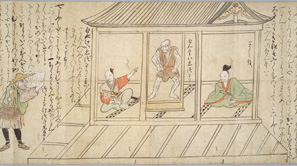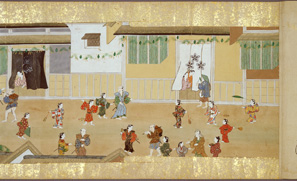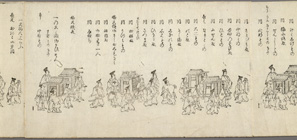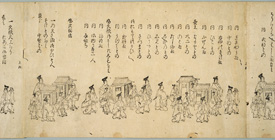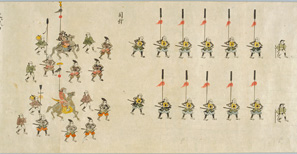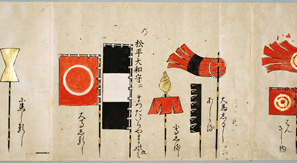This picture scroll illustrates a story of Minamoto Yoshitsune, a military commander at the end of the 12th century, and his follower, Benkei, who were expelled from Kyoto and arrived at Hiraizumi, Oshu Province. This story was very popular by being adapted to dramas and novels
Home > 3. Variety of "ehon" books > Picture Scrolls
The history of Japanese illustrated books started with picture scrolls in the Heian (794 to 1185) and Kamakura Periods (1185 to 1333). In the Edo Period (1603 to 1867), a wide variety of illustrated books were produced: nara-ehon were manually painted and written; block printed books with illustrations colored with paintbrushes are called tanroku-bon; illustrated books printed in black ink such as block prints of Moronobu's ukiyoe; and illustrated books printed in multicolor by making full use of elaborate block printing techniques.
The majority of such books were drained away overseas at the end of the Edo Period through the Meiji Period--from 1853 to 1912. Today, it is rare for the people to see these books in Japan. And these books, which are called ehon (picture books), have been great favorites as works of art in Europe and in the United States. This artistic beauty comes from a good combination of pictures, letters, printing and binding.
NDL boasts of its largest collection of such illustrated books in Japan. In recent years, NDL has made much effort to collect high-quality illustrated books that are particularly regarded as bibliographically important.
For the Section III of this exhibition, we select representative items from our collection.
55. Yoshitsune Oshu kudari
- copied in the late Muromachi Period (16th century), 1 scroll, 29.6cm in length <WA31-18>
56. Junigatsu asobi
- 2 volumes, copied in the Kanbun and Enpo Eras (17th century), 2 scrolls, 32.7cm in length <WA31-19>
This colored picture scroll introduces annual events and seasonal plays in Kyoto by month. Beside Japan, the Chester Beatty Library in Ireland also has the same type of picture scroll.
57. Kan'ei sannen Nijo jo gyoko
- volume I and volume II (of a three-volume material), printed around the 4th year of Kan'ei Era (1627), 2 scrolls, 26.7cm in length <WA7-229>
This picture scroll depicts the procession of Emperor Gomizunoo to visit Tokugawa Hidetada and Tokugawa Iemitsu at Nijo-jo Castle in September, 1626 (3rd year of the Kan'ei Era). Both pictures and letters are printed in type: the one and only example in the printing history of Japan.
58. Kan'ei gyoko ki
- 3 volumes, printed in the Kan'ei Era (1624 to 1644), 3 scrolls, 26.2cm in length <WA7-257>
This is another edition of No.57. This edition is printed with new letter and picture types. The two editions look the same, but you will find that different types are used when the details are compared.
59. Ohatamoto sonae saho
- copied around the mid Edo Period (17th-18th century), 1 scroll, 24.5cm in length <WB35-4>
This picture scroll depicts a military commander taking up a position before starting a battle. For this picture, solders and horses are stamped, although uma-jirushi (battle standards) and banners are painted with brushes.
60. Ouma jirushi
- 6 volumes, printed in the Kan'ei Era (1624 to 1644), 6 scrolls, 23.5cm in length <WA8-7>
On this scroll, "uma-jirushi" (battle standards set up beside the commander's horse in the battlefield to show the location or position) of 170 soldiers of the warlike period are painted. The illustrations are printed in color, and also colored by hand. This is an important material, being the origin of nishiki-e, multicolor block prints of Japan. Volume VI, which has been found recently, is the only one scroll that still remains today.


